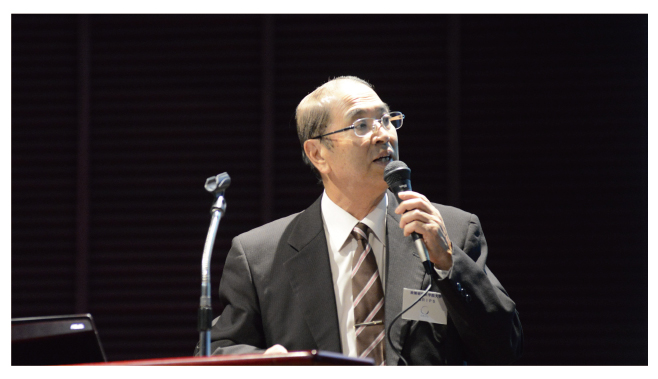News Archives
2015.12.7
Professor Sachio Ehara, one of Japan’s leading advocates for geothermal power generation gives the 118th GRIPS Forum.

As the largest gathering of world leaders in history begin a multinational effort toward forging what many call the planet’s last, best hope to stave off the worst consequences of climate change in Paris, the challenge for governments worldwide is how to adopt the use of renewable energy and in turn reduce their carbon footprints. On top of this, policy makers are faced with a broad range of renewable energy technology options each with their own complex modes of power generation, transmission and distribution methods.
The renewable energy source that is perhaps the least understood but has the most unrealized production capacity is geothermal energy, which uses the heat trapped in the earth to generate electricity. It was this renewable energy source that was the focus of the 118th GRIPS Forum, given by Professor Emeritus of Kyushu University, Sachio Ehara.
It is Ehara’s view that the choice of policies or regulatory regime that a country should adopt, must be tailored to the conditions of the country’s energy system, market, supply/demand volume, risks, and administrative capacity. Considering that Japan has the world’s third largest geothermal reserves and the required technology to produce geothermal turbines, the answer for Japan’s energy future is a no brainer for the Professor – he has often referred to geothermal energy as a ‘gift from the earth.’ The safety factor of geothermal energy production is particularly poignant in light of the tragic events in Japan’s recent past, when Japan suffered the worst nuclear catastrophe in a generation with triple reactor core meltdowns at the Fukushima Daiichi nuclear power plant in 2011.However, when analyzing recent trends of geothermal power generation around the world, Ehara claims that whilst the world is making progress in this relatively new technology, Japan is lagging behind. In fact, he asserts that Japan’s total geothermal power generation permitted output has remained stagnant since 1996.
‘Despite of the quantity of resources and technological strength in Japan, the utilization of geothermal power has not advanced. There is great potential to utilize this inexhaustible resource for Japan’s energy future. Compared to other forms of renewable energy, geothermal power generation is also considered to be an effective technology due to the fact that geothermal power plants can operate non-stop, 24 hours a day, 365 days a year.’
Ehara points to 3 major factors as to why the country has been dragging its feet in harvesting a larger proportion of energy from its resource rich sub-terrain.
The first is cost, which he cites as having been as much as 2 to 3 times higher than coal-fired thermal and nuclear power prior to 2011. However, since Japan’s new feed-in tariff* (“FIT”) system was introduced in 2012, investment prospects in geothermal have greatly improved. It is hoped that the surge in investment into research and development of geothermal technology as well as adequate surveying will see costs come down in the long term.
The second reason why Japan has seen slow development of geothermal energy is that the areas where most of the energy is accessible and available, (areas where active volcanoes exist) have been designated as national parks, where development has been severely restricted. Ehara claims that over 80% of promising resources are situated inside national parks. He believes more relaxation of regulations on development inside Japans’ national parks need to occur, but stipulates they must come with strict guidelines that demand high quality design for power plants and comprehensive environmental impact assessments.
‘Developers need to make efforts by incorporating new environmental technologies to protect national parks and widely communicate with people that it is possible to produce geothermal power generation cleanly without compromising the natural beauty of the surrounding environment.
The third and final reason Ehara cites as to why Japan has been slow to embrace geothermal power sources relates to community concerns that surrounding natural features such as hot springs, mud pools, geysers, and steaming ground can be easily, and irreparably, damaged by geothermal development. Whilst Ehara notes that there hasn’t been any reported negative impact on surrounding natural geothermal features across the seventeen existing geothermal power plants of Japan, other countries such as New Zealand and the Philippines have reported depletion issues. The Professor asserts that ‘in order to avoid exerting impacts, it is important to review and apply measures scientifically and technically. Of all factors involved, sustainable production is crucial.’
Public attitudes toward and acceptance of geothermal power technologies still has a way to go in Japan, but the vigorous dialogue that is taking place regarding risk management will according to Ehara slowly create a reality where geothermal energy plays a major role in Japans’ overall electricity mix. Back to the climate talks however, Japan has taken a 2030 renewable energy target of 22-24% (with geothermal at 1.0~1.1%) to Paris, which many argue could be much more ambitious (up to 10% by 2050) considering the country’s wealth, R&D capacity, innovation coupled with its production capacity in geothermal energy.
*Effective July 1, 2012, the New feed-in tariff (“FIT”) system introduced by the Japanese Government forces power utilities to purchase electricity from applicable renewable energy sources, including solar, wind, hydro, geothermal, biomass, and others, generated by certified power generating facilities at a fixed price for a given period with the goal of providing sufficient incentives for new investments in renewable energy projects.
Article written by GRIPS Public Relations Department.





